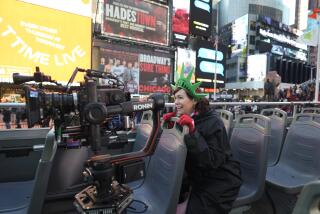A look inside Hollywood and the movies. : Off-Centerpiece : Actually, in Today’s Hollywood, 21 Is Getting Up There
A running joke in Hollywood goes something like this: Anyone can claim to be a producer. More often than not, though, it means they produce one thing--their business card--and they do it every chance they get.
At only 21, Tanya York is producing more than that: She’s got two features in the can and three on the way. She hasn’t been to college, let alone film or business school. She’s managed to raise several million dollars at a time when funding for independents is hard to come by. And as a woman barely out of her teens she is an anomaly in an industry dominated by thirty-something and fortysome-thing-year-old men.
What York produces should not be confused with high art: “The Deadly Avenger” was a raw action movie starring Jan Michael Vincent and Erik Estrada that went straight to video. Her upcoming film is “Hell Comes to Frogtown II,” a Ninja turtles-type tale that York--with an earnest face--describes as being set “after a nuclear holocaust, on a mutant reservation of frog creatures.” (If you missed the first “Frogtown,” you’re not alone: New World Pictures ran out of money before it could be released into theaters, but the film now has a small cult following on video and late-night cable TV.)
But in an era when Hollywood studios are gambling tens of millions of dollars per movie (industry insiders are wagering that “Hudson Hawk” will be lucky to make back a fraction of its budget), York’s busy production company is a reminder that independents are making scores of low-budget movies each year that do make money. What it usually takes is a couple of familiar names in the cast and some inventive filming: The “Frogtown” interiors, for example, were shot inside empty space upstairs from York’s own modest Hollywood Boulevard office.
York herself was inspired by watching movies that cost $70,000 bring in $800,000, or $2-million movies making $8 million--all without ever reaching theaters. These tiny films become profitable because of the proliferation of other outlets--such as video, TV and foreign markets.
By designing a business plan based on revenues from these ancillary markets, York was able to persuade a small group of investors to put up money for five movies ranging in budgets from $1 million to $2 million. “She has a tremendous business drive, and she was able to make the contacts,” says Donald G. Jackson, director of both “Frogtown” movies.
Born in Jamaica and raised in London, York appears to have inherited her business acumen from her mother, who made a small fortune by developing and selling a system of speed-learning for typing. At age 15, York left school to help manage her mother’s business and went on to do some acting and modeling.
When she and her mother moved to Los Angeles a couple of years later, York worked as an extra on films before parlaying an internship on the low-budget feature “Roller Blade Warriors” into a makeup and production design position. She got her first break as an associate producer when actor/producer/director David Heavener hired her on “Twisted Justice” and “Old Scores.”
“I was working on small, independent exploitation movies, so you could do a lot more than what you were hired for,” York said.
For her next films, she is developing a project about UFOs, a horror movie that will probably attract an NC-17 rating, and is negotiating the sequel rights to the action-adventure picture “Cage.”
York raised the money to make her own slate of films in less than a year. Since then, says Gene Margoluis, a former Columbia Pictures distribution executive now selling rights to York’s pictures, “she’s delivered every single thing she said she would. . . . I’d stake my reputation on her: Someday this girl is going to be a force in the business.”
It’s probably too early to predict that. But York is keenly aware that, for now at least, she’s better off outside mainstream Hollywood. After talking philosophically about the advantages of small production companies, she candidly adds: “There’s no way I could have walked into a studio anyways.”
More to Read
The biggest entertainment stories
Get our big stories about Hollywood, film, television, music, arts, culture and more right in your inbox as soon as they publish.
You may occasionally receive promotional content from the Los Angeles Times.










